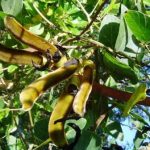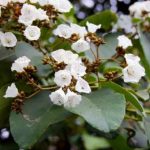TREE LIFE
July 2003
WHILE THE CURRENT FUEL CRISIS PERSISTS IT IS IMPORTANT TO CONFIRM WITH ANY OF THE COMMITTEE MEMBERS THAT THE SCHEDULED OUTINGS AND WALKS CAN ACTUALLY TAKE PLACE. SEE THE BACK PAGE FOR PHONE NUMBERS.
MASHONALAND CALENDAR
Saturday 5th July. Botanic Garden Walk with Tom Müller. Meet in the car park at 10.45 for 11am. This week’s subject is Boraginaceae – Ehretias and Cordias and so on. There are not many species involved but there are some definite taxonomic difficulties.
Sunday 20th July. To Darryl Tiran in the Arcturas area. This sounds wonderful “typical hill brachystegia with a good mix of combretums, gardenias, duikerberries, rubber trees etc, down to quite thick riverine vegetation.”.
To add some excitement we are told to beware of many open mining pits and puff adders are abundant. Hopefully the latter will be asleep during the winter.
Meet at 9.30a.m. Bring your lunch and a chair.
Saturday 26th July. Mark’s Walk will be in the Greengrove Bird Sanctuary.
Sunday 27th July. As part of the anniversary celebrations of the History Society, Lyn Mullin will be giving a talk on the history of forestry in Zimbabwe, including a look at early planted trees (1907-13).
Bring a picnic lunch and meet at 11.30am – 12 at the Forest Research Station, Orange Grove Drive (off Enterprise Road)
Saturday 2nd August. Botanic Garden Walk.
MATABELELAND CALENDAR
Nothing has been arranged for July
*
TREE & GRASSES IDENTIFICATION WEEK-END 13th – 14th SEPTEMBER
What Tree is that? How do you tell Lonchocarpus capassa from Lonchocarpus nelsii? What does the bark of a Teak tree look like? How do you use the Camelthorn to cure ear infections and headaches? Which grasses do Buffalo prefer?
If you are interested in learning the answers to any of the above questions then this exciting and informative week-end planned by National Parks at Hwange Main Camp is for you. Come along and join one of the many walks and lectures planned for the week-end 13th and 14th September 2003.
Leading the walks will be a number of well-known and expert Botanists from private enterprise, the Zimbabwe Bio-diversity Foundation, Forestry Commission, the National Herbarium and Botanical Gardens, including Ms Nozipho Nobanda, Head of the National Herbarium and Dr Jonathan Timberlake, Botanist with the Bio-diversity Foundation. Morning and afternoon walks, of around 2 hours duration, will be conducted to show visitors the grasses and trees of such habitats as Teak forests, Acacia scrub, Mopane bush and open grasslands. In the evening we will have a number of speakers who will open up the world of Kalahari-sand trees and grasses, make tree identification easy and talk on the history of Forestry in the Park. We are also hoping to secure the services of a local botanist who will explain the many traditional and medicinal uses of local tree species. This will be a fun but informative week-end and walks will be graded to cater for those who are only just beginning to appreciate trees up to those who already have a good knowledge of our vegetation – everyone is welcome.
No visit to Hwange would be complete without a drive into the Park and apart from daytime drives, as this is a Full-Moon week-end, there is also the option of driving in the Park at night and stopping at Nyamandhlovu Platform to experience exciting nocturnal wildlife activities. There will also be time to socialise and during the evening there will be a performance by the Main Camp Primary School Marimba and Dance group, plus the very talented new conservation drama group, Miombo. This group performs plays written to spread the conservation message by means of mime, song and dance. Please note there are no extra costs for this entertainment, although both dance groups would appreciate donations. It is suggested that visitors drive to Hwange Main Camp on Friday so they are in place for Saturday morning activities.
Note: Several other special week-ends are planned; Bird Identification & Falconry week-end 17th & 18th May; Symphony Under the Stars 14th & 15th June; Art In The Park 11th & 12th October. Please contact us direct for full details: Tel: (018) 371/374/685/654
GREYSTONE PARK. 18th May 2003
The Annual General Meeting of the Tree Society was held at the home of Rob and Gillian Smith in Greystone Park. The Minutes of the Meeting will be published on another occasion. This report covers the arboreal aspects of the day.
Seventeen members met for morning tea; just enough for a quorum for the meeting, much to the Chairman’s relief. The meeting itself was held under a well-grown Cordyla africana in the front garden. After it was over, the Smiths took us on a conducted tour of their garden. We took a good two hours to walk 100 metres, which must be a record for the Tree Society, never renowned for the speed of its progress.
The reason for our slow pace was the density of trees in what is just an average-sized suburban garden. The Smiths have been collecting and planting trees, nearly all indigenous, since 1984, and now have 764 specimens representing 374 species, which are all neatly catalogued. Admittedly, some are tiny seedlings, but many are very well grown, and the general impression is of a belt of forest round the perimeter of the property. The soil is red doleritic, with raised rocky outcrops in one area, and it is astonishing how many species of trees from diverse habitats, from eastern highlands to the lowveld, have been able to establish and even thrive in such an environment. The garden is an example to us all of what can be achieved in a very limited area, given enthusiasm and perseverance. It is also a paradise for birds.
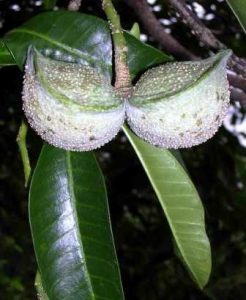
Tabernaemontana elegans. Photo: Bart Wursten. Source: Flora of Zimbabwe
I have no intention of trying to list the trees that we looked at during our walk; it would be an abridged version of Coates Palgraves’ book. The species that stick in my mind are: a group of Tabernaemontana elegans, with their toad-like fruit, along the path from the gate to the front door; a grove of very well grown, flat-topped Albizia gummifera between the house and the road; scattered Acacia xanthophloea, with their striking yellow-green bark, at the edge of the lawn; and a large-leafed Anthocleista grandiflora rising above its neighbours at the far end of the garden. For the connoisseur, there were many species which are rarely encountered on outings; Mark made a list of those he wanted to look at over lunch, which we ate under the Cordyla, and we trooped off to see them in the afternoon. For the novice, the great benefit of the collection was the close proximity of related species, at least ten Acacia, four Albizia, three Commiphora, and goodness knows what else, so that one could compare and contrast them and learn their distinguishing features at all seasons of the year. With that in mind, it would be worth remembering the kind invitation to members by Rob and Gillian to visit them at any time to look at their trees.
It was a thoroughly enjoyable and interesting visit, and we are most grateful to our hosts for their hospitality.
-J.A. Larence
*
BOTANIC GARDEN WALK: 7 JUNE 2003 ACACIAS CONTINUED
Tom continued his discussion of acacias. How to get a grip on this large genus?
The most obvious approach is to look at the thorns and ask two questions: firstly, are they (straight) spines or (curved) prickles (or both in a few cases)? and then, secondly, how are they arranged – in pairs, in threes or scattered? This allows one to break down the species into slightly more manageable groups.
Tom mentioned another approach and that was to think of acacias as a continuum from those with a small number of pinnae and few large leaflets (Acacia nigrescens would probably be the extreme at one end) to those with a very large number of pinnae and very numerous leaflets (I’m not so sure what would be at this end – perhaps Acacia sieberiana or rehmanniana).
In this account we will break them down using the former approach.
GROUP 1: We first looked at three species which fall into the group with prickles scattered along the stem, namely: schweinfurthii, pentagona and adenocalyx.
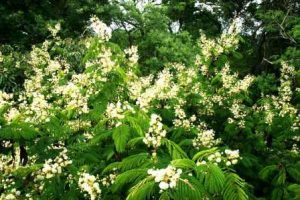
Acacia schweinfurthii. Photo: Bart Wursten. Source: Flora of Zimbabwe
Acacia schweinfurthii has spherical flowers, the young branches have prominent raised angles and the pods tend to be raised over the seeds. This is a low to medium altitude species, typically climbing in riverine vegetation. Tom mentioned that occasionally it comes up to higher altitudes. It makes a good security fence and is quite easy to grow. It has been planted to conceal mines in river beds.
[Note that it could be confused with Acacia ataxacantha but that species has flowers in spikes (the arrangement of the pods when in fruit can be used to deduce what the flowering inflorescence shape was) and a smaller gland on the petiole.]Acacia pentagona is one of the few acacias to occur in montane forest. Tom mentioned emerging from some forest cut and bleeding from this species. Timberlake explains that this species occurs mainly in low and medium altitude forest, rarely achieving higher altitudes. The flowers, like those of schweinfurthii, are spherical.
Acacia adenocalyx is an extremely rare species, having been found only once in Zimbabwe “on Chibvudza Hill near the Nyandire bridge in Pfungwe Communal Land, Rushinga” (per Timberlake). It is not particularly distinctive and I can quite understand that it could be easily overlooked. Again, it is like A. schweinfurthii in having spherical flowers but it is a smaller more delicate plant, a smaller gland at the leaf base and discolorous leaflets.
GROUP 2: The next group we looked at were some with straight thorns in pairs.
Acacia grandicornuta is a species of low altitudes in SE Zimbabwe; it occasionally has exceptionally large, expanded thorns, as the specific name suggests. Tom remarked that it looks quite like A. karroo in general appearance (although karroo does not generally occur at lower altitudes) but grandicornuta lacks the red branches and the flowers are white.
Acacia arenaria is a species of western Zimbabwe and Botswana; typically the stems are zigzag and the leaves are long with many pinnae. It is usually a multi-stemmed shrub. Timberlake remarks that this species in Zimbabwe prefers “previously cleared or disturbed areas on red clay soils” and sand is not its usual habitat as it is in Botswana.
Acacia robusta subsp. robusta is a climax component of west country savannah woodland. It has marked “cushions” on the stems and the fruit are relatively broad; the leaflets are relatively large and the leaves have 2-3 pinnae; the leaflets are dark green.
Acacia robusta subsp. clavigera is somewhat different to subsp. robusta. Ecologically, subsp. clavigera is a riverine species typically occurring along draining lines and along the rivers of the great river systems such as the Zambezi and Sabi rivers. In this taxon the species are more sickle-shaped. It is often a very large tree and the “cushions” are less marked.
Acacia kirkii is an extraordinary species. For a start, there are the strange and distinctive raised knobs on the pods over the seeds. Another feature is the strongly peeling green bark – rather like Commiphora marlothii. It is a rare species in Zimbabwe growing on ancient alluvium.
Acacia gerrardii. A species with a large number of pinnae and leaflets. The flowers are white and the pods grey and sickle-shaped.
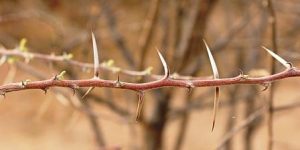
Acacia luederitzii. Photo: Orty Bourquin. Source: Flora of Zimbabwe
Acacia luederitzii is basically a plant with straight paired thorns (and spherical inflorescences). However, some of the shorter thorns are curved and confusion can occur. This has relatively small leaves and it grows in Zimbabwe’s west country and Botswana where it is very much a feature of the Kalahari sand.
Acacia erioloba (formerly known as giraffae). This is tree of the Kalahari sand, sometimes very large and becoming flat-topped. The pods are notably broad; the leaves are of a karroo type. The bark is rough. It is a very important tree in agro-forestry and cattle ranching in particular.
The “glandular acacias”
These are a subgroup of the straight, paired thorns group, with pods which bear reddish, and often sticky glands. In Zimbabwe there are 4 species: borleae, exuvialis, nebrownii and permixta. In neighbouring countries are also found swazica, tenuispina and torrei. Acacia karroo sometimes bears glands and is related to this group. All but three of these are found in the palaeo-Limpopo basin, i.e. the basin drained by the Limpopo 4 million years ago. A full and fascinating discussion of these species is to be found in Jonathan Timberlake’s book.
GROUP 3: Curved prickles in pairs
Acacia caffra. This species occurred at Tynwald on the western side of Harare (is it still there?), where it was generally thought to have been introduced. There is also a record from Wedza mountain which really needs to be verified. This is known as the Common Hook-thorn in Coates Palgrave, presumably because it is so common in South Africa.
Acacia goetzei / burkei / welwitschii complex
Tom remarked that this group is still not fully understood. Of the three, goetzei and burkei are essentially woodland species whereas welwitschii is riverine.
Acacia polyacantha. A common species with us, generally with very distinctive whitish trunk and branches and an exceptionally large gland on the petiole.
Once again, a fascinating walk and we are very grateful to Tom for his time and patience. I’d also to add that the Field Guide to the Acacias of Zimbabwe by Timberlake, Fagg and Barnes (1999) was very useful in compiling this article.
-Mark Hyde
THE GENUS PITTOSPORUM
This genus of 150-200 species is predominantly a native of Australia and New Zealand, but it has a strange and very much wider distribution than that, being also found in the Canary Islands, West Africa, East Africa, Southern Africa, Madagascar, Hawaii, Polynesia, the Himalaya, China, and Japan. The other genera of the family Pittosporaceae-Billardiera, Bursaria, Cherianthera, Citriobatus, Hymenosporum, Marianthus, Pronaya, and Sollya are almost entirely confined to Australia, and one wonders why it is that Pittosporum should be so widespread.
The name Pittosporum derives from pittos (resin or pitch) and sporum (seed), and refers to the resinous coating of the seeds.
Our indigenous Pittosporum viridiflorum (cheesewood) is the only species of the genus in southern Africa, and it also extends northwards at least into Kenya (which has 2 other species) and eastwards into Madagascar. It is widespread in southern Africa, extending down into the Cape, and is common in a wide range of altitudes and soil types. Within Greater Harare it is very common in the rocky hills of Glen Lorne, particularly on the property, Charmwood, which the Tree Society has visited several times on Mark’s Saturday afternoon walks.
There is nothing particularly remarkable about the species, but it could be a very ornamental tree in a garden. It is easily raised from seed or cuttings. The pale-coloured wood is moderately useful for rough furniture or shelving, and the bark has been used for medicinal purposes to treat stomach disorders. TR Sim (1906) in The Forests and Forest Flora of the Colony of the Cape of Good Hope noted that a decoction of the bark of P. viridiflorum was used by farmers to treat gall sickness and redwater in cattle.
The specific name viridiflorum of our species refers to its greenish flowers, which are quite strongly scented. There are some interesting African names for P. viridiflorum-the Central Shona (Korekore and zezuru) muchemedzambuya (and variants) possibly refers to charms carved from the softish wood for making oneself or another person popular, but it could also have connotations of mourning (for a grandmother or an old lady). The Central Shona (Manyika) name mukwenkwe is the same as the name umkwenkwe noted by TR Sim in his work quoted above, or the Zulu and Xhosa name umkhwenkwe in Elsa Pooley (1993), The Complete Field Guide to Trees of Natal, Zululand, & Transkei. The Shona (Zezuru) name murunganyama derives from the use of parts of this plant (among others) by old-time hunters for flavouring meat while out on their hunting trips. These plants are now used for flavouring other foods as well (H. Wild, 1972, A Rhodesian Botanical Dictionary of African and English Plant Names, revised and enlarged by HM Biegel & S Mavi). The (unspecified) Central Shona name mugarambinga refers to one of the species’ habitats (gara = to live at or in, and binga = forest).
Exotic ornamental species of Pittosporum that have been recorded in Zimbabwe are P. eugenioides (lemonwood) and P. tenuifolium from New Zealand, P. rhombifolium and P. undulatum (cheesewood) from Australia, and P. tobira(tobira) from China and Japan (HM Biegel, 1977, Check-List of Ornamental Plants Used in Rhodesian Parks and Gardens). An oil is extracted from the fragrant flowers of P.undulatum, and its wood is used in the manufacture of golf clubs (DJ Mabberley, 1993, The Plant-Book).
Another member of the family Pittosporaceae, Hymenosporum flavum (Australian frangipani or sweet shade), is a common ornamental tree up to 6-10 m tall in Harare.
-Lyn Mullin
*
TERMITARIA
I have just posed the following question to a friend Jannette D Mitchell who works for a Termite Research Unit in Pretoria. “The old question of which comes first the chicken or the egg, which comes first the termitaria or the tree. I have always been quite happy that the termite comes first builds a termitaria and the tree finds the ideal conditions and establishes itself.
But in South Luangwa Valley having pontificated about that I did see the beginnings of a number of termitaria up the side of Tamarindus indica. Do you know of this phenomenon or of somebody who might do so? Is there a particular species that eats the bark of the tamarind exclusively and gradually expands the mound?
Jan replied: With regard to your query regarding the termites and the trees – it is a bit of both. Finding termitaria associated with trees is quite common to a number of species of both termites and trees. My theory is that when the alates fly the female (usually) settles first and “calls” and she generally chooses some height off the ground (probably to the avoid ground predators) – tops of grass or branches/ trunks of bushes and trees. The male is attracted to her scent and settles behind her and then the two set off down the stem in what is known as a tandem pair – the male maintaining close contact all the way. When they reach the ground she looks for a suitable site for digging-in to create a nest. She will investigate any unevenness on the surface by climbing in and curling her body around the edge – its a touch thing – the more of the side that is in contact with a surface the better she likes it – and that is often just the kind of thing that the base of the tree will provide. That is one possibility to explain the phenomenon but it is equally possible that there are specific soil conditions close to trees that aid survival of the new colonies – only something like 0.003% of the alates that fly actually survive for three years (which is when the first signs of the mound appear above ground). But it also true in cases that the termitaria come first. Quoting Coaton (Mr Termite)
– “modern termite mounds do not support vegetation until the sub-soil of which they are composed has weathered …. weathered soil erodes off the mound and is deposited around the base of the mound, gradually giving rise to a low hummock on top of which the modern mound is situated (as termites continually repair the mound as it erodes). Over time as the structure increases in diameter and height one ends up with huge vegetated termite hills” Of course the sub-soil brought to the surface will have nutrients that have leached out down to deeper layers and so be more fertile than surrounding soil, furthermore the termite nest is always damp and warm. Another interesting point Coaton makes is that ” there is a school of thought which regards the termite hills as relics of a previous age when the climate of Zambia (he was working up there at the time) was far wetter than it is today. This theory is based on the fact that the plant species which thrive on the termite hills are peculiar to such sites, and are seldom present in the surrounding woodland off the hills. At Choma, for example, the tree species found on the termite hills do not occur in the surrounding woodland, but are found in the woodland off the hills in the more tropical Ndola area. The trees on the termite hills in Ndola, in turn do not occur in the surrounding woodland off the hills, but are common in the woodland off the hills in the more tropical Northern province” Species from Ndola area termite hills: Bigonia sp., Maerua triphylla [M. pubescens], Rourea [Byrsocarpus] sp., Combretum molle, Allophylus africanus, Zanthoxylum chalybeum [Fagara chalybea].
When you say ” there is a school of thought which regards the termite hills as relics of a previous age when the climate of Zambia (he was working up there at the time) was far wetter than it is today.” That is exactly what I have been saying: “the climate was far wetter than it is today and I don’t mean in the last 10 or even 100 years and trees with a higher moisture requirement have survived on termite mounds, in riverine fringes and in the eastern districts in Zimbabwe where there is a higher moisture availability”. It is so nice to find someone else talking in the same vein that I do.
-Meg Coates Palgrave
SALINATION OF WETLANDS
Salination is caused by changes in the delicate balance between surface water and ground water systems. In many agricultural areas of Australia water tables are rising because perennial native vegetation has been replaced with crops and pastures that use less water. As it rises, the groundwater dissolves naturally occurring soil salts and brings them towards the surface.
A rising water table can cause salination of freshwater wetlands in two ways. Low-lying swampy areas can become overwhelmed as saline groundwater rises up through their beds. Alternatively, salt that has been brought to the surface and deposited in surrounding farmland can be washed into the wetlands as surface runoff after rain. In addition, clearing of native vegetation means that less rainwater is trapped by the vegetation and more runs off into the wetlands. There is simply more water about, so seasonal wetlands are wetter for longer.
Any attempt to address the problem of salination must tackle these three issues and the complex interactions between them.
With acknowledgements to the Spring 1994 issue of Landscope.
Postscript
Salination has also been a cause for concern in Zimbabwe’s lowveld region where pockets of salinity have become apparent in the irrigated sugar estates. It would appear that the causes of salination here are much the same as those experienced in Australia-too much additional water being applied to sites that had never before had such an abundance to leach away the naturally occurring salts. In our case, native vegetation adapted to very low rainfall was replaced by agricultural crops that needed a great deal of water for their best growth and productivity, and it is this very water that is responsible for bringing the salts to the surface. The Zimbabwean problem is not nearly as great as the one in Australia, where large areas of former eucalypt forest and woodland have now become saline deserts (whether permanent or temporary), but the danger signs have appeared in Zimbabwe to tax the ingenuity of local experts. This problem serves to show that it is not enough just to whack on water if you want profitable crops; you’ve also got to know your soils, and you’ve got to know how to manage the water.
-Lyn Mullin
*
In Retrospect Continued – Lyn Mullin
THE MILKY WAY
From the Nyarupinda Catchment in TREE LIFE No.136 (June 1991) there was an article titled “Milk Cells in Trees, Shrubs, Lianes and Herbs”, which is worth repeating:
The moment the surface of a latex-bearing plant is broken, `milk’ wells up, forced out of damaged latex tubes that have elastic walls. Differentiated in the embryo, these laticiferous cells grow as the plant grows, and permeate all the tissues. These simple or branched tubes may attain a length of more than a metre, the longest cells in the plant kingdom. Latex may occur in columns of cells, or in layers.
A description of all the possible constituents would fill a book, eg alkaloids, grains of starch and protein, sugars, enzymes, gum-resins, fats, and oil. Globules of rubbery substances in emulsified form give it its milky appearance. In addition to this sticky fluid, do these plants have normal sap in their living cells? The answer must be yes….
Research on latex suggests that its role inside the plant is to isolate toxic waste, to `fix’ water to counter water-stress, and to enable distribution of substances by dissolving them. The whole story is not yet known.
Externally the `milk’ may be a caustic or poisonous protection for the plant’s survival to make it distasteful. Veld- poisoning may occur when famine forces animals to eat these plants. Exuded latex coagulates and makes a covering for all kinds of wounds. Wound-gum in trees, mentioned last month, has a different origin, but serves the same purpose.
It is best to skip the economic and ornamental importance of latex plants in favour of their universal use for primitive hunting, shooting, and fishing – as bait, or arrow and fish poison. Sticky sap captures very small birds when they are lured to twigs twirled in boiled latex – urimbo (birdlime) is collected from slanting chops on the trunk of a `milk’ tree, eg Ficus stuhlmannii. It is important to identify poisonous species – their sap is potent and all parts of these plants should be handled with care.
To be continued
ROOT NOTE – Lyn Mullin
Choosy Squirrels Shape Oak Forests
Not all acorns are the same to squirrels, say biologists Michael Steel and Peter Smallwood. White Oak (Quercus alba) acorns sprout in the fall, making them unsuitable for storing. The furry hoarders tend to eat them on the spot; those overlooked sprout near their parent tree. Red oak (Q. rubra) acorns don’t germinate until spring. Squirrels bury them some distance away for winter food – but sometimes fail to recover them – thus helping red oaks disperse.
(From the National Geographic Magazine, July 1999)
MARK HYDE CHAIRMAN


